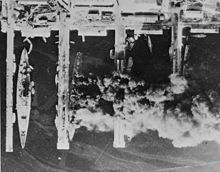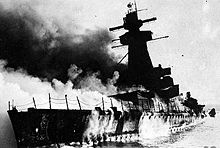Self-immersion
As scuttling of a ship is called the deliberate sinking by its own crew . It is usually done by opening the hull below the waterline . Throughout history, individual ships and entire fleets have been scuttled for various reasons. In doing so, those who carried out the self-sinking measures were often in danger of not being able to save themselves from the sinking ship in time.
Methods
Any ship can be self-sunk by ripping open the hull with explosive charges . This is often the quickest method of sinking a ship if sufficient explosives are used.
In addition, the hull can also be torn open by the targeted ramming of obstacles such as reefs or rocks. This method is particularly suitable for making a self-sinking appear like an accident. But there is also the possibility that the ship remains resting on the obstacle and therefore does not sink.
On ships with wooden or plastic hulls, you can sink your own ship by punching holes in the side of the ship with axes or similar tools, or by setting the ship on fire, which ultimately also causes the hull to leak. Other measures must be applied to ships with metal hulls.
- For this purpose, existing openings in the hull below the waterline, which z. B. direct cooling water to the machine or drain waste water, are opened to the ship interior. This can be done by opening sea valves or loosening connected lines. Since these pipe openings are usually small, they alone would only cause the ship to sink very slowly.
- So-called bottom valves were installed in the hull of the ship from the 18th century. Actually intended to allow bilge water to run off in the shipyard, water could also enter the hull through these openings and cause it to sink.
- In addition, flood valves later came into use, which were intended for trimming in the event of uneven loading or, on warships, for counter-flooding after damage. In order to use this to sink a ship, the hatches between the watertight compartments, which otherwise limit water ingress , have to be opened on modern ships .
purpose
Most of the time, self-sinking occurred in armed conflicts in order not to let ships fall into the hands of the enemy, so that they could not be used against the owner or so that no knowledge about military technology or secret documents could be gained on board. In individual cases, the final destruction was not intended, but the ship should later be able to be lifted and repaired for personal use. Mostly older ships were also used by self-sinking as a means of warfare to block ports or sea routes.
Merchant ships and pleasure craft are also repeatedly scuttled with fraudulent intent in order to receive an (excessive) insurance premium or to save disposal costs.
Only in a broader sense were ships self-sunk as breakwaters in shallow water and as solid ground for mooring other ships. When the Allies landed in Normandy during World War II , two artificial harbors (→ Mulberry Harbor ) were created for the landing of the troops. In recent times ships have been repeatedly sunk as artificial reefs and attractions in diving tourism. In the strict sense of the word, this no longer represents a self- sinking, as these ships were already out of service, had been technically prepared for the sinking and had no crew at all to carry out a self- sinking.
Examples

- In the 11th century, Vikings repeatedly sank ships loaded with stones near Skuldelev in the Roskildefjord in order to impede or block the access through the fjord.
- During the War of the Spanish Succession and in view of the siege of Toulon (1707) , the enclosed French Mediterranean fleet sank on the orders of King Louis XIV
- During the Northern War , the Swedish fleet trapped by the Danish fleet after the sea battle at Fehmarn (1715) in the Bay of Kiel sank itself.
- In 1733, three ships loaded with stones and ballast were sunk in the Elbe estuary near Cuxhaven . The wrecks served as the basis for the construction of a jetty, the old love .
- In the Crimean War (1853-1856) the Black Sea Fleet behaved passively after the appearance of British and French fleets and was limited to the defense of the port city of Sevastopol , the ships were only used as floating coastal batteries . When Sevastopol fell in 1856, the crews sank the remaining ships to prevent the Allies from using Sevastopol Bay.
- In 1916 the steamship Goetzen was sunk by its German crew members in the shallow waters of Lake Tanganyika . The holds were filled with sand and the machine was heavily greased to make it easier to put it back into operation later.
- In 1919 the Imperial High Seas Fleet sank in Scapa Flow to prevent it from being taken over by the World War winners. To do this, the sea valves were opened and then treated so that they could no longer be closed, and the doors between the watertight sections wedged in the open position.
- After the October Revolution in Russia, the Black Sea Fleet went under the red flag of the Bolsheviks . During the Russian Civil War , the fleet threatened to fall into the hands of counter-revolutionaries or foreign interventions; On June 18, 1918, Lenin gave the order to sink the fleet. However, part of the Black Sea Fleet joined the so-called White Movement , which fought against the results of the October Revolution in the Russian Civil War, and supported the White Army's struggle against the Bolsheviks in the Black Sea region.
- On December 6, 1939, the German passenger ship Ussukuma was self- sunk in order not to be attacked by the British cruiser HMS Ajax .
- On December 17, 1939, the crew sank the Admiral Graf Spee of the German Navy themselves off the coast of Uruguay , as the captain saw his ship in a hopeless situation after a brief mission at the beginning of the Second World War .
- On December 19, 1939, the German passenger steamer Columbus was self- scuttled by its crew.
- In 1942 the fleet of the French Vichy regime sank on the orders of the Admiralty in front of the Mediterranean port of Toulon . The ships were not intended to become prey weapons for the Germans.
- On August 29, 1943, most of the Danish Navy sank itself to prevent the German Navy from taking over the ships . Some ships escaped to Sweden and formed the Danish flotilla there .
- During the Second World War, German submarines , which were forced to surface in a hopeless position, sank themselves. Even shortly before and after the surrender of the Wehrmacht in May 1945, a large number of the remaining submarines were after the code "Rainbow" was issued. sunk by their own crews.
swell
- Gino Galuppini: Encyclopedia of Warships. Weltbildverlag, Augsburg 1995, ISBN 3-89350-828-7
- Dan van der Vat: Battlefield Atlantic. Heyne Verlag, Munich 1990, ISBN 3-453-04230-1
